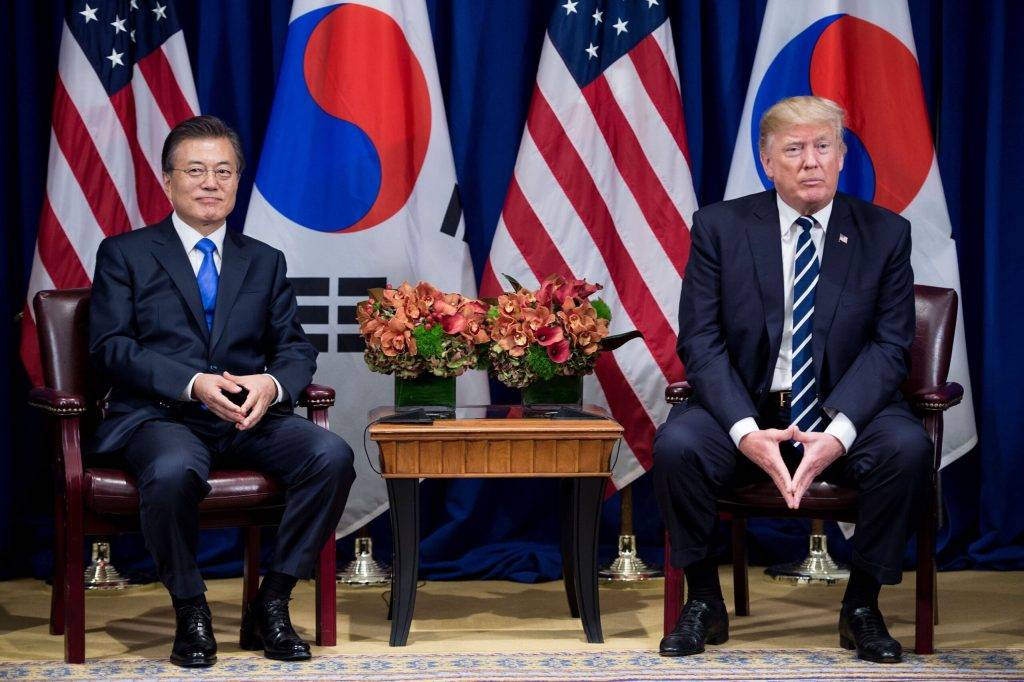TL;DR – Trump‘s demands test Seoul’s patience
- President Trump is pushing for a $350 billion investment from South Korea, with a contentious demand for upfront cash or equity, which Seoul argues could destabilise its financial markets.
- Anticipating a cooler reception, public demonstrations reflect South Korean discontent, with fears of economic coercion and resentment stemming from a recent US ICE raid on Hyundai.
Trump’s demands test Seoul’s patience
US President Donald Trump has two clear priorities for his trip to South Korea on Wednesday as part of his five-day tour of Asia.
The first is for South Korea’s government to finalise a $350 billion (€300 billion) investment package in the United States, and the second is to arrange another face-to-face meeting with North Korean leader Kim Jong Un.
After successful visits to Malaysia and Japan, where Trump inked beneficial trade and security deals, analysts say his maximalist ambitions from his visit to South Korea are likely to be more difficult to achieve.
The $350 billion deadlock
The South Korean administration of President Lee Jae-myung is standing its ground on the massive investment package that is being demanded in return for the reduction of US tariffs on Korean imports.
Officials in South Korea said the bulk of the $350 billion investment had been earmarked for loans and loan guarantees to South Korean companies setting up new facilities in the US.
Trump, however, wants Seoul to pay the total in cash or equity “up front.” Lee said that such a cash outlay would destabilise the country’s financial markets, putting the investment deal in doubt.
A cool South Korean welcome
Trump may not receive a warm welcome from the people of South Korea.
There have been several demonstrations outside the US embassy in central Seoul over the past few days. Some South Koreans even feel their nation is being strong-armed into trade deals and fear that Trump might once again threaten to withdraw US forces if his demands are not met.
There is still lingering resentment over a raid by US Immigration and Customs Enforcement (ICE) on a Hyundai plant in the US state of Georgia in September. Over 300 South Korean workers were detained before being returned to Seoul.
South Korea’s Foreign Minister Cho Hyun told reporters on Friday that since the ICE raid on the South Korean carmaker, Seoul and Washington have agreed to establish a working group to create a new visa category for future South Korean investment projects.
South Koreans question cost of US alliance
“For many South Koreans, the United States has long been regarded as the country’s most important security partner,” said Hyobin Lee, a professor at Sogang University in Seoul.
“However, under the Trump administration, there is a widespread perception that the alliance is being leveraged for unilateral economic gains.”
“The idea that South Korea must make large-scale investments simply to avoid being disadvantaged by US tariffs has been received by many as a sense of betrayal,” she told DW.
Washington and Seoul have said that they are narrowing their differences over the $350 billion investment package that the US is demanding in return for the US reducing tariffs from 25% at present to 15%.
In an interview with Bloomberg, Lee said that a number of sticking points remain, including the amount of the investment, the timeline, the method of investment and how the losses and profits will be shared.
“The US will of course try to maximize its interests, but it must not be to the extent that causes catastrophic consequences for South Korea,” Lee said.
Kim Sang-woo, a former politician with the left-leaning South Korean Congress for New Politics and now a member of the board of the Kim Dae-jung Peace Foundation, says the US demand is widely seen as “huge.”
“The US is asking Korea to make the investment mostly in the form of cash while Seoul wants it in credits, but the total is about 6.5% of our total GDP and if Korea agreed to that then it could have an enormous negative impact on our financial stability,” he said.
Security in Northeast Asia
Lee is due to host Trump for a bilateral summit on the sidelines of the Asia-Pacific Economic Cooperation (APEC) summit in the South Korean city of Gyeongju.
Aboard Air Force One flying from Malaysia to Japan on Monday, however, Trump indicated he hopes to rekindle the “bromance” of his first spell in the White House with Kim Jong Un.
“I’d love to meet with him, if he would like to meet,” Trump told reporters. He made a similar offer on Friday, saying, “I put it out over the internet that I’m coming to South Korea and if he would like to meet, I’m open to it.”
Analysts say it is impossible to determine whether the meeting will go ahead as both men are unpredictable and spontaneous but there have been no positive hints emerging from Pyongyang.
The last time Trump and Kim met was in June 2019 at the village of Panmunjom on the North-South border. Their first meeting in Singapore in June 2018 had been positive, but the relationship frayed badly after the collapse of talks in Hanoi in February 2019.
In the meantime, Kim has signed a military and trade alliance with Russia, dramatically easing many of the shortages North Korea was experiencing in fuel, food and other necessities due to international sanctions on the regime.
“It is always possible that they could meet, but I see Kim as trying to get as much out of Trump as he can if they do meet,” said Kim Sang-woo.
“On the other hand, Trump is looking to promote the visuals of him meeting Kim rather than offering anything substantial. I do not think that would be enough to convince Kim.”
South Korea ‘has changed’
Sogang University’s Lee said the US administration needs to understand that South Korea’s political leadership “has changed,” particularly when it comes to trade.
“The current administration is expected to pursue negotiations in a more assertive and confident manner,” she said.
Lee added that Trump “may hope to conclude a major investment agreement to reinforce his reputation as a skilled negotiator,” adding that the South Korean government is expected to approach talks pragmatically, prioritising economic interests and strategic autonomy.
“Whether a deal is reached will depend on whether the terms are mutually beneficial rather than perceived as one-sided.”


